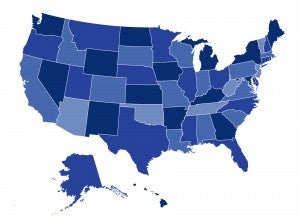
In our latest report for The Commonwealth Fund, we examined key structural, operational, and policy decisions made by 17 states and the District of Columbia that chose to establish a state-based exchange for 2014. The report, Implementing the Affordable Care Act: Key Design Decisions for State-Based Exchanges, is sixth in a series on Affordable Care Act (ACA) implementation, covering state action on topics that include state implementation of the early market and 2014 reforms as well as state decisions on an essential health benefits benchmark plan and initial decisions on exchange establishment. (For more on this project, check this out.)
What does the ACA do? The Affordable Care Act requires the establishment of new health insurance marketplaces, known as exchanges, in every state by October 1, 2013. Exchanges are intended to address the current barriers to affordable and adequate health coverage in the individual and small-group markets by providing a seamless, one-stop experience for individuals to apply for financial assistance, compare health plans, and enroll in public or private coverage. Similarly, Small Business Health Options Program (SHOP) exchanges are designed to aggregate the purchasing power of small businesses; enable employers and employees to compare a wider range of coverage choices; and reduce administrative costs.
Under the Affordable Care Act, states can choose to establish a state-based exchange or default to a federally facilitated exchange. States running their own exchanges must meet federal criteria, but have substantial flexibility in how they do so. This report examines key design decisions made by the 17 states and the District of Columbia that chose to establish a state-based exchange. (For purposes of this report, we refer to Utah as a state-based exchange, although it is pursuing a “bifurcated” model in which the state runs the SHOP exchange and federal government runs the individual exchange).
What did we find? Our report focused on decisions that states made to structure a sustainable exchange, foster a competitive marketplace, promote meaningful consumer choices, improve options for small employers, and maximize enrollment in the exchanges. We found that states made significant progress in making dozens of critical decisions to implement the core exchange functions of plan management, financial management, eligibility and enrollment, and consumer assistance and outreach. In making these decisions, states leveraged their flexibility under the Affordable Care Act to tailor their exchanges to the needs of their consumers, businesses and insurance markets, and with an eye towards outcomes, such as enrollment, consumer experience, and sustainability.
We found that states sought to provide better choices and value to consumers and businesses in their states, in many cases exceeding federal requirements or moving ahead of federal timelines to do so. States also employed innovative strategies to tackle common challenges like encouraging plan participation, mitigating adverse selection, and maximizing enrollment. For example:
- Many states moved ahead with quality data reporting for health plans on their exchanges. Nine states—California, Colorado, Connecticut, Maryland, Massachusetts, Minnesota, New York, Oregon, and Rhode Island—plan to display quality data on their marketplaces in 2014, two years before the federal government requires such data to be displayed.
- Small business employees in state-run marketplaces will have more choice sooner than required. Nearly every state-run SHOP marketplace will provide small businesses the ability to offer their employees a choice of more than one plan starting in 2014. The federal government does not require this level of choice until 2015. In addition, eight states—Hawaii, Minnesota, Nevada, New York, Oregon, Rhode Island, Utah, and Vermont—will let employers offer employees the choice of any plan on the SHOP marketplace.
- States balanced providing a range of plan choices with ease of comparing plans. Eight states—California, Connecticut, Kentucky, Massachusetts, Maryland, New York, Oregon, and Vermont—and the District of Columbia required insurers to offer plans at coverage levels beyond the two (silver and gold) that are required by the Affordable Care Act, with several states choosing to also limit the number of plans each insurer could sell on each metal tier coverage level and requiring insurers to offer some standardized plans.
For even more findings, check out the full report and press release from The Commonwealth Fund, along with the Fund’s accompanying interactive map.
What do our findings mean? The Affordable Care Act established a national framework for reform while retaining significant flexibility for states to implement its provisions. Since the law’s enactment, states have made significant progress in making the multiple design decisions necessary to tailor their exchanges to the needs of their consumers, businesses, and insurance markets. Despite the significant hurdles inherent in establishing an exchange, our report makes it clear that states are looking beyond “Day One” operational challenges to focus on important long-term policy goals. Exchange design decisions—along with other important policy choices such as whether to expand Medicaid and how to enforce the Affordable Care Act’s market reforms—could affect key outcomes, such as enrollment, cost, consumer experience, and sustainability. As we enter the first year of exchange operations, it will be critical to monitor and analyze the impact of exchange design decisions on these and other real-world outcomes.

